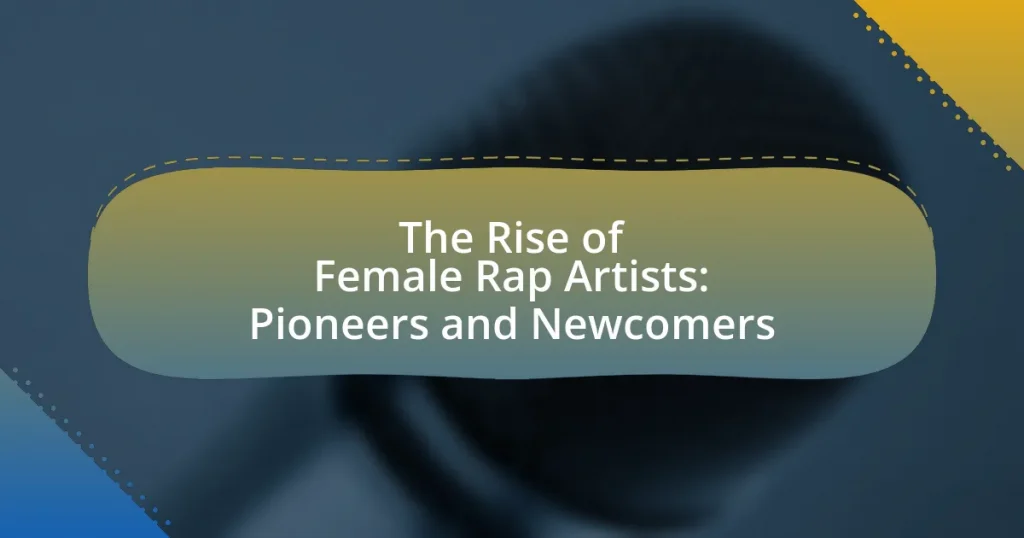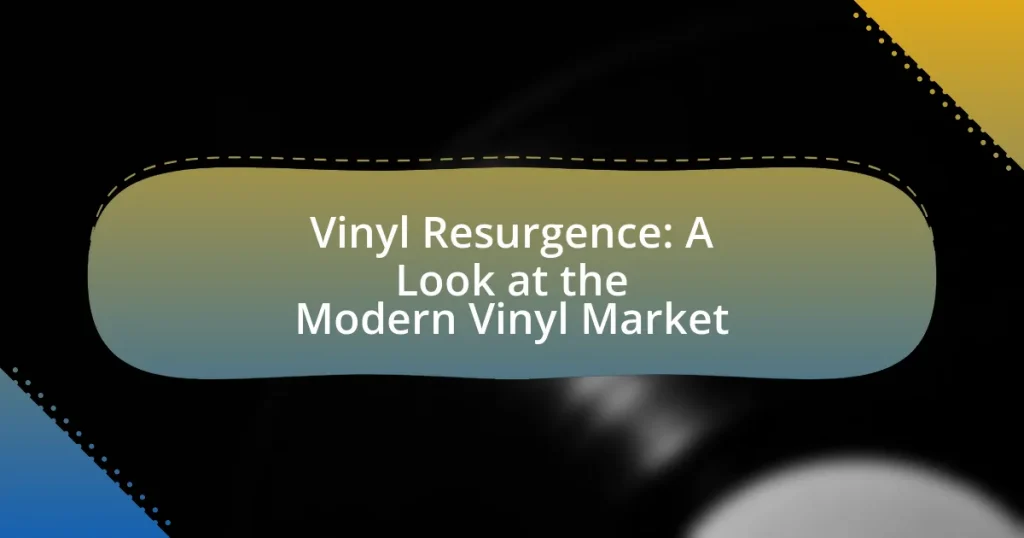The article examines the rise of female rap artists, highlighting their significance in challenging gender norms and enhancing diversity within the music industry. It discusses the historical contributions of pioneering artists such as MC Lyte and Queen Latifah, as well as the impact of contemporary figures like Nicki Minaj and Cardi B, who have achieved commercial success and reshaped the genre’s narratives. Key milestones, societal influences, and the importance of representation are explored, alongside the challenges faced by female artists in gaining recognition. The article also addresses the evolving themes in female rap and the role of social media in promoting new talent, ultimately showcasing the transformative legacy of women in hip-hop.
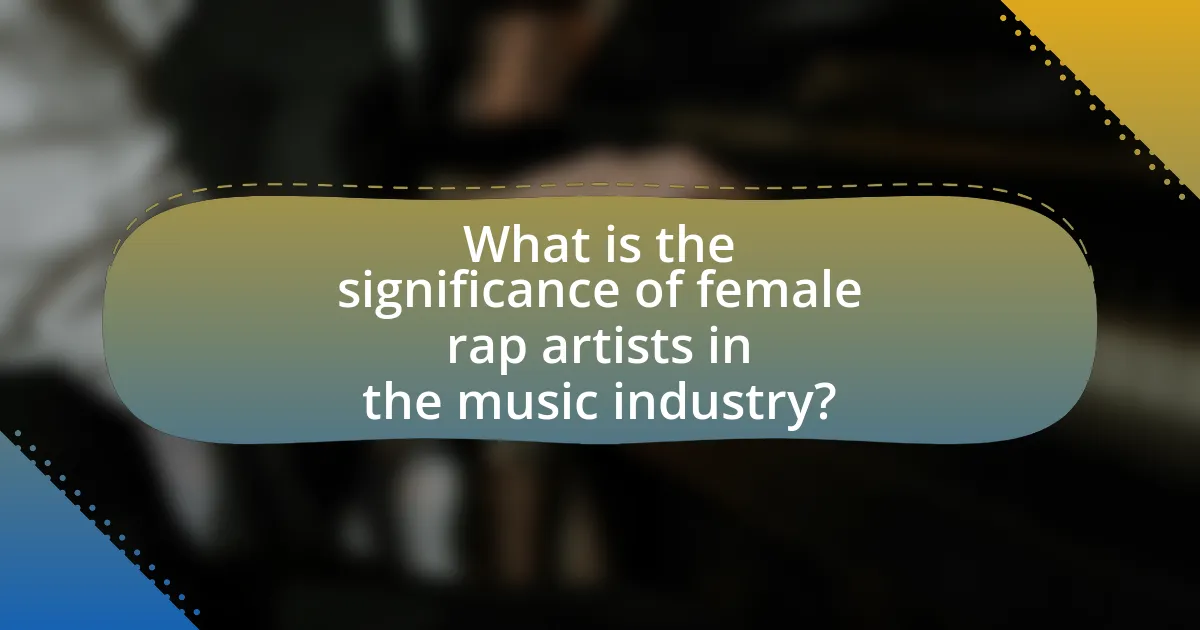
What is the significance of female rap artists in the music industry?
Female rap artists are significant in the music industry as they challenge gender norms and expand the genre’s diversity. Their presence has led to increased visibility and representation for women in hip-hop, historically dominated by male artists. For instance, artists like Nicki Minaj and Cardi B have achieved commercial success, with Minaj being the first female artist to have over 100 entries on the Billboard Hot 100 chart. This success not only paves the way for future female artists but also influences the themes and narratives within the genre, promoting empowerment and addressing social issues. The rise of female rap artists has transformed the industry landscape, making it more inclusive and reflective of varied experiences.
How have female rap artists influenced the genre over the years?
Female rap artists have significantly influenced the genre by expanding its themes, diversifying its sound, and challenging gender norms. Pioneers like MC Lyte and Queen Latifah paved the way in the late 1980s and early 1990s, introducing narratives that addressed social issues and women’s empowerment. In the 2000s, artists such as Missy Elliott and Lil’ Kim brought innovative styles and bold aesthetics, reshaping the visual and auditory landscape of hip-hop. More recently, artists like Nicki Minaj and Cardi B have further pushed boundaries, achieving commercial success and mainstream recognition while addressing topics like sexuality and personal agency. Their contributions have not only enriched the genre but also inspired a new generation of female artists, leading to a more inclusive and varied hip-hop culture.
What are some key milestones achieved by female rap artists?
Key milestones achieved by female rap artists include the first Grammy Award for Best Rap Solo Performance won by Queen Latifah in 1994, establishing recognition for women in the genre. Additionally, Missy Elliott became the first female rapper inducted into the Songwriters Hall of Fame in 2019, highlighting her influence and contributions to songwriting in hip-hop. Furthermore, Cardi B’s “Bodak Yellow” reached number one on the Billboard Hot 100 in 2017, making her the first solo female rapper to achieve this since Lauryn Hill in 1998. These milestones reflect the significant impact and progress of female artists in the rap industry.
How have societal changes impacted the rise of female rap artists?
Societal changes have significantly impacted the rise of female rap artists by fostering an environment that promotes gender equality and diversity in music. The feminist movements of the late 20th and early 21st centuries have challenged traditional gender roles, allowing women to express themselves more freely in a male-dominated industry. For instance, the increased visibility of female empowerment themes in popular culture has led to a surge in female rap artists like Nicki Minaj and Cardi B, who have achieved commercial success and critical acclaim. Additionally, social media platforms have provided these artists with direct access to audiences, enabling them to build their brands independently and challenge industry norms. This shift is evidenced by the growing number of female artists charting on Billboard’s Hot 100, reflecting a broader acceptance and celebration of women’s voices in hip-hop.
Why is representation important in the rap industry?
Representation is important in the rap industry because it ensures diverse voices and experiences are heard, which enriches the genre and fosters inclusivity. The presence of female rap artists, such as Queen Latifah and Nicki Minaj, has challenged gender stereotypes and provided role models for aspiring artists. Studies show that increased representation leads to broader audience engagement; for instance, a report by Nielsen in 2020 highlighted that female artists accounted for 30% of the top 100 songs in hip-hop, indicating a growing acceptance and demand for diverse perspectives. This representation not only empowers women in the industry but also influences cultural narratives and societal norms surrounding gender and race.
How does female representation in rap affect young artists?
Female representation in rap positively influences young artists by providing diverse role models and expanding the genre’s creative landscape. The presence of successful female rappers, such as Nicki Minaj and Cardi B, demonstrates that women can achieve commercial success and artistic recognition in a male-dominated industry. This visibility encourages young female artists to pursue their ambitions, fostering a sense of empowerment and validation. Research indicates that female artists often address themes of empowerment and resilience, which resonate with young listeners and aspiring musicians, thereby inspiring them to express their own narratives through music.
What challenges do female rap artists face in gaining recognition?
Female rap artists face significant challenges in gaining recognition, primarily due to systemic gender bias and industry gatekeeping. The male-dominated nature of the hip-hop industry often leads to female artists being marginalized or overlooked, with only a small percentage of women receiving mainstream attention. For instance, a study by the Annenberg Inclusion Initiative found that only 22.5% of artists in popular music were women, highlighting the disparity in representation. Additionally, female rap artists frequently encounter stereotypes that undermine their credibility and artistry, making it difficult for them to be taken seriously. These challenges are compounded by a lack of support from industry executives and media platforms, which often prioritize male artists in promotional efforts.
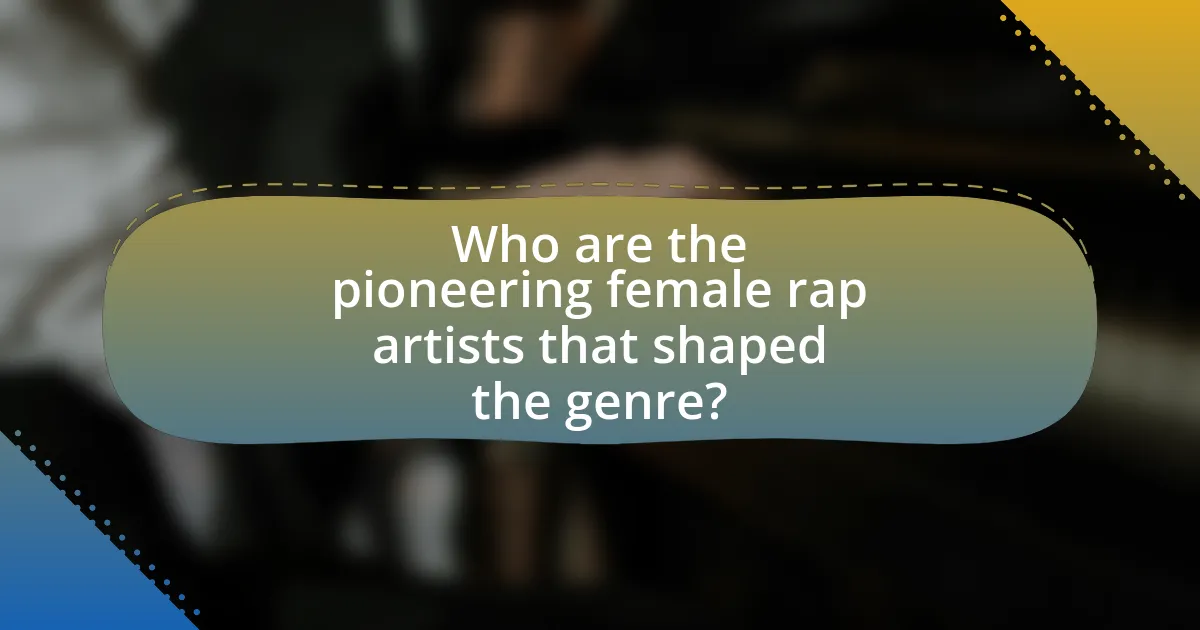
Who are the pioneering female rap artists that shaped the genre?
The pioneering female rap artists that shaped the genre include MC Lyte, Queen Latifah, and Salt-N-Pepa. MC Lyte, who debuted in 1988 with “Lyte as a Rock,” is recognized for her lyrical prowess and influence on future female rappers. Queen Latifah, with her 1989 album “All Hail the Queen,” broke barriers by addressing social issues and promoting empowerment. Salt-N-Pepa, known for their hit “Push It,” were among the first all-female rap groups to achieve mainstream success, significantly impacting the visibility of women in hip-hop. These artists laid the groundwork for future generations, establishing a strong presence for women in a predominantly male-dominated genre.
What contributions did artists like MC Lyte and Queen Latifah make?
MC Lyte and Queen Latifah significantly contributed to the hip-hop genre by breaking gender barriers and promoting empowerment through their music. MC Lyte was one of the first female rappers to gain recognition in a male-dominated industry, with her debut album “Lyte as a Rock” in 1988 showcasing her lyrical prowess and paving the way for future female artists. Queen Latifah, with her debut album “All Hail the Queen” in 1989, not only highlighted social issues such as racism and sexism but also emphasized self-respect and female empowerment, becoming a role model for women in hip-hop. Both artists have received numerous accolades, including Grammy Awards, which validate their impact and influence in shaping the narrative for women in rap music.
How did their music challenge stereotypes in hip-hop?
Female rap artists challenged stereotypes in hip-hop by asserting their individuality and addressing themes traditionally overlooked in the genre. For instance, artists like Queen Latifah and Missy Elliott incorporated messages of empowerment, self-respect, and social issues, which contrasted with the prevalent male-centric narratives. Their lyrics often tackled topics such as gender equality and body positivity, thereby redefining the role of women in hip-hop. Additionally, the commercial success of female artists demonstrated that audiences were receptive to diverse perspectives, further validating their contributions and challenging the notion that hip-hop was solely a male domain.
What legacy did these pioneers leave for future generations?
The pioneers of female rap artists left a legacy of empowerment and representation for future generations. They broke gender barriers in a predominantly male industry, paving the way for women to express their voices and experiences through rap. Artists like MC Lyte and Queen Latifah not only showcased lyrical talent but also addressed social issues, influencing subsequent generations to use their platforms for advocacy. Their contributions established a foundation for the acceptance and celebration of female artists in hip-hop, leading to a diverse array of voices and styles in the genre today.
Which other influential female rap artists emerged in the 1990s and 2000s?
Influential female rap artists who emerged in the 1990s and 2000s include Missy Elliott, Lil’ Kim, and Eve. Missy Elliott debuted in the 1990s with her unique style and innovative music videos, becoming a key figure in hip-hop and winning multiple Grammy Awards. Lil’ Kim, also emerging in the 1990s, is known for her bold lyrics and fashion, significantly impacting the genre and paving the way for future female artists. Eve gained prominence in the late 1990s and early 2000s with her hit singles and collaborations, earning a Grammy Award and establishing herself as a versatile artist in both music and acting.
What impact did Missy Elliott and Lil’ Kim have on the genre?
Missy Elliott and Lil’ Kim significantly transformed the hip-hop genre by introducing a bold, unapologetic representation of female sexuality and empowerment. Missy Elliott’s innovative production techniques and genre-blending style, exemplified in hits like “Get Ur Freak On,” pushed the boundaries of hip-hop, while her lyrical content often challenged societal norms regarding women. Lil’ Kim, with her provocative fashion and assertive lyrics in tracks like “Crush on You,” redefined femininity in rap, paving the way for future female artists to embrace their sexuality and assert their presence in a male-dominated industry. Their contributions not only elevated the visibility of women in hip-hop but also inspired a new generation of female artists to express themselves authentically and confidently.
How did their styles differ from earlier pioneers?
Female rap artists’ styles differed from earlier pioneers primarily through their incorporation of diverse themes and personal narratives. While earlier pioneers often focused on social issues and party anthems, newer female artists emphasize empowerment, sexuality, and individuality in their lyrics. For instance, artists like Nicki Minaj and Cardi B blend personal experiences with mainstream pop influences, creating a more commercial sound that contrasts with the raw, grassroots approach of pioneers like MC Lyte and Queen Latifah. This evolution reflects a broader cultural shift towards celebrating female agency and complexity in hip-hop, marking a significant departure from the more singular focus of earlier female rappers.
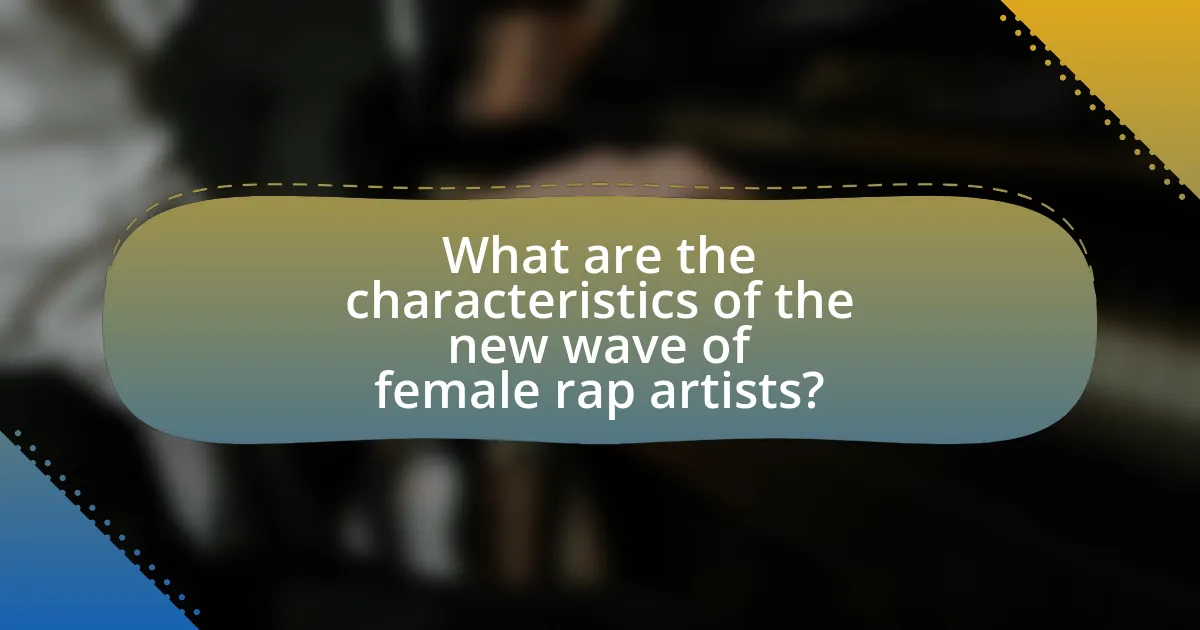
What are the characteristics of the new wave of female rap artists?
The new wave of female rap artists is characterized by their authenticity, versatility, and empowerment themes. These artists often blend various musical styles, including trap, R&B, and pop, showcasing their adaptability in the evolving music landscape. Additionally, they frequently address social issues, personal experiences, and self-empowerment in their lyrics, reflecting a shift towards more meaningful content in hip-hop. For instance, artists like Megan Thee Stallion and Cardi B have gained prominence for their bold expressions of sexuality and independence, resonating with a diverse audience. This trend is supported by the increasing visibility and commercial success of female rappers, as evidenced by their frequent appearances on Billboard charts and major award nominations, indicating a significant impact on the genre.
How do contemporary female rap artists differ from their predecessors?
Contemporary female rap artists differ from their predecessors primarily in their increased visibility, autonomy, and diverse representation in the genre. Unlike earlier female rappers, who often faced significant barriers and were frequently marginalized, modern artists like Nicki Minaj, Cardi B, and Megan Thee Stallion have achieved mainstream success and recognition, often dominating charts and award shows. This shift is evidenced by the fact that in 2020, women accounted for 30% of the Billboard Hot 100’s top 10, a significant increase from previous decades. Additionally, contemporary artists often embrace a broader range of themes, including empowerment, sexuality, and personal narratives, reflecting a more nuanced understanding of female identity in hip-hop. This evolution highlights the changing landscape of the genre, where female voices are not only heard but celebrated.
What themes are commonly explored in the music of new female rap artists?
New female rap artists commonly explore themes of empowerment, self-identity, and social issues. Empowerment is often highlighted through lyrics that promote confidence and resilience, reflecting the artists’ journeys and challenges in a male-dominated industry. Self-identity is frequently examined, with artists expressing their unique experiences, cultural backgrounds, and personal narratives. Additionally, social issues such as gender inequality, racism, and mental health are prevalent, as these artists use their platforms to address systemic problems and advocate for change. For instance, artists like Megan Thee Stallion and Cardi B have gained recognition for their bold statements on female autonomy and societal expectations, reinforcing the significance of these themes in contemporary rap music.
How has social media influenced the rise of new female rap artists?
Social media has significantly influenced the rise of new female rap artists by providing them with platforms to showcase their talent and connect directly with audiences. This democratization of music distribution allows emerging artists to bypass traditional gatekeepers, such as record labels and radio stations, which historically limited access to the industry. For instance, platforms like Instagram, TikTok, and YouTube enable female rappers to share their music, engage with fans, and build a following without the need for substantial financial backing.
Moreover, the viral nature of social media content has led to the rapid discovery of new talent; artists like Megan Thee Stallion and Doja Cat gained prominence through viral challenges and trends on these platforms. According to a 2021 report by the Recording Industry Association of America, streaming and social media engagement have become crucial for new artists, with over 70% of music listeners discovering new music through social media. This shift has empowered female rap artists to carve out their niche and gain recognition in a competitive landscape.
Who are some of the most notable newcomers in the female rap scene today?
Some of the most notable newcomers in the female rap scene today include Ice Spice, Coi Leray, and Doechii. Ice Spice gained significant attention with her viral hit “Munch (Feelin’ U)” and has quickly established herself as a prominent figure in the genre. Coi Leray, known for her energetic style and tracks like “No More Parties,” has also made waves in the industry, earning nominations for major awards. Doechii has garnered acclaim for her unique sound and has been recognized for her breakout single “Persuasive.” These artists exemplify the fresh talent emerging in the female rap scene, contributing to its dynamic evolution.
What unique styles do artists like Megan Thee Stallion and Doja Cat bring to the genre?
Megan Thee Stallion and Doja Cat bring distinct styles to the rap genre, characterized by their unique blend of confidence, humor, and versatility. Megan Thee Stallion is known for her assertive lyrics and powerful delivery, often incorporating themes of empowerment and self-confidence, as seen in hits like “Savage” and “Body.” In contrast, Doja Cat combines rap with pop and R&B elements, showcasing her playful and eclectic approach in songs like “Say So” and “Kiss Me More.” Both artists challenge traditional gender norms in hip-hop, using their platforms to express individuality and creativity, which has contributed to their significant impact on the genre.
How are these newcomers reshaping the perception of female rappers?
Newcomers in the female rap scene are reshaping the perception of female rappers by challenging traditional stereotypes and showcasing diverse narratives. Artists like Megan Thee Stallion and Doja Cat have gained mainstream success, emphasizing empowerment, confidence, and individuality in their lyrics and public personas. This shift is evidenced by Megan Thee Stallion’s Grammy wins and Doja Cat’s chart-topping hits, which highlight their artistic versatility and ability to connect with a broad audience. As a result, these newcomers are redefining the genre, moving beyond the hypersexualized portrayals of the past and establishing a more nuanced and multifaceted image of female rappers.
What challenges do new female rap artists face in the industry?
New female rap artists face significant challenges in the industry, including gender bias, limited access to resources, and underrepresentation in key decision-making roles. Gender bias manifests in the form of stereotypes that often undermine their credibility and artistry, leading to a lack of support from industry gatekeepers. Limited access to resources, such as funding and promotional opportunities, restricts their ability to produce and market their music effectively. Additionally, underrepresentation in executive positions within record labels and management firms results in fewer opportunities for female artists to influence the industry landscape. According to a 2021 report by the Annenberg Inclusion Initiative, only 22.5% of artists in the music industry are women, highlighting the systemic barriers that new female rap artists must navigate to achieve success.
How do issues of sexism and misogyny manifest in the rap industry today?
Sexism and misogyny in the rap industry today manifest through lyrical content, industry gatekeeping, and the treatment of female artists. Many rap songs contain derogatory language and objectification of women, reinforcing harmful stereotypes. For instance, a study by the University of Southern California found that 70% of rap lyrics analyzed contained misogynistic themes. Additionally, female artists often face barriers to entry and recognition, with male counterparts receiving more promotion and support. This disparity is evident in award nominations and radio play, where female rappers are frequently underrepresented. Furthermore, incidents of harassment and discrimination within the industry highlight the pervasive culture of sexism, as reported by various media outlets covering the experiences of women in rap.
What strategies can new female rap artists use to overcome these challenges?
New female rap artists can overcome challenges by leveraging social media for self-promotion, collaborating with established artists, and focusing on unique storytelling in their lyrics. Social media platforms like Instagram and TikTok allow artists to reach wider audiences without traditional gatekeepers, as evidenced by the rise of artists like Megan Thee Stallion, who gained fame through viral content. Collaborations with established artists can provide credibility and exposure, as seen with Cardi B’s partnerships that boosted her visibility. Additionally, emphasizing personal narratives in their music can resonate with listeners, creating a strong emotional connection, which has been a successful strategy for artists like Nicki Minaj.
What can aspiring female rap artists learn from their predecessors and contemporaries?
Aspiring female rap artists can learn the importance of authenticity and resilience from their predecessors and contemporaries. Artists like Queen Latifah and Missy Elliott paved the way by embracing their unique identities and experiences, demonstrating that personal storytelling resonates with audiences. Additionally, contemporary figures such as Nicki Minaj and Cardi B showcase the power of self-promotion and social media engagement, highlighting how building a personal brand can enhance visibility and success in the industry. The success of these artists illustrates that staying true to oneself while strategically navigating the music landscape is crucial for aspiring female rappers.
What best practices should they follow to succeed in the industry?
To succeed in the music industry, particularly as female rap artists, they should focus on building a strong personal brand and networking effectively. A strong personal brand helps artists differentiate themselves in a competitive market, while effective networking opens doors to collaborations and opportunities. For instance, successful female rappers like Nicki Minaj and Cardi B have leveraged social media platforms to cultivate their brands and connect with fans and industry professionals. Additionally, continuous skill development in songwriting, performance, and production is crucial, as it enhances their artistic capabilities and marketability. According to a report by the Annenberg Inclusion Initiative, female artists who actively engage in their craft and collaborate with others tend to achieve greater visibility and success in the industry.
How can they leverage social media to build their brand and audience?
Female rap artists can leverage social media by creating engaging content that showcases their unique style and personality, thereby attracting a dedicated audience. Platforms like Instagram, TikTok, and Twitter allow these artists to share music snippets, behind-the-scenes footage, and personal stories, which fosters a deeper connection with fans. For instance, artists such as Megan Thee Stallion and Cardi B have effectively used TikTok to promote their songs, resulting in viral challenges that significantly boost their visibility and engagement. According to a 2021 report by Statista, 54% of social media users follow brands or artists, indicating that a strong social media presence can directly contribute to audience growth and brand loyalty.










